The limitations of policy coordination in the euro area under the European Semester
This paper assesses economic policy coordination in the euro area under the European Semester. Despite the collective decision to create this new syst
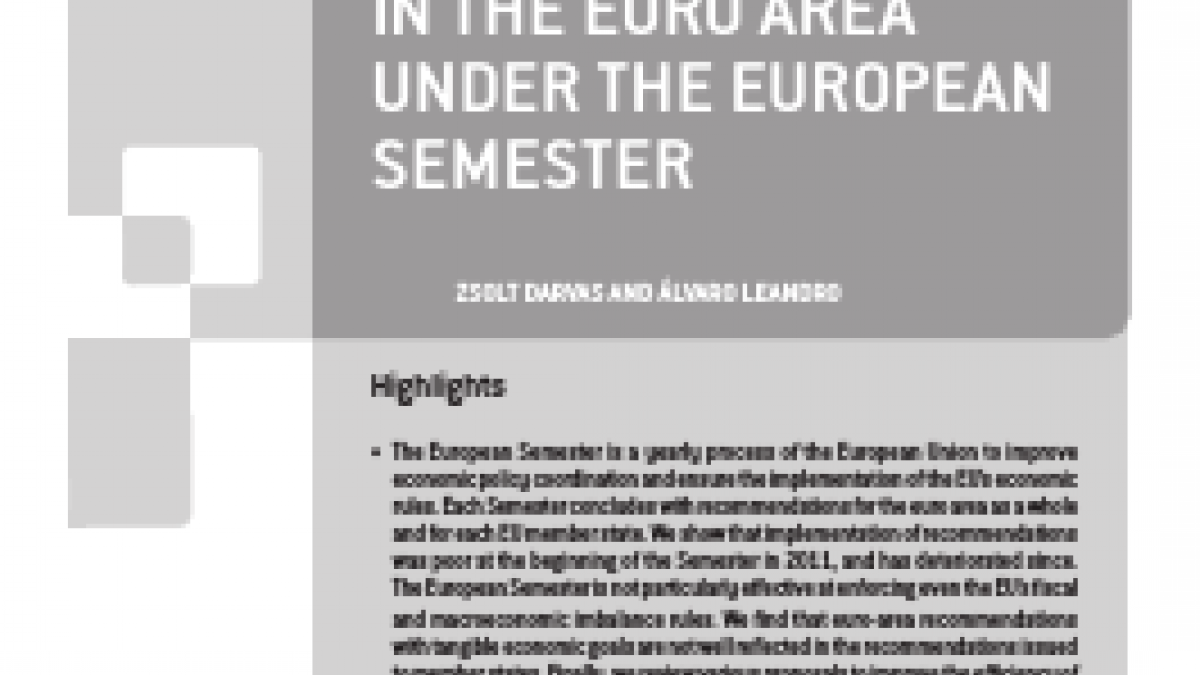
This paper was requested by the European Parliament’s Economic and Monetary Affairs Committee for the Economic Dialogue with the President of the Eurogroup, 10 November 2015. It was originally published
under the title "Economic policy coordination in the euro area under the European Semester". This document is also available on Economic and Monetary Affairs Committee homepage. Copyright remains with the European Union.
Highlights
- The European Semester is a yearly process of the European Union to improve economic policy coordination and ensure the implementation of the EU’s economic rules. Each Semester concludes with recommendations for the euro area as a whole and for each EU member state.
- We show that implementation of recommendations was poor at the beginning of the Semester in 2011, and has deteriorated since. The European Semester is not particularly effective at enforcing even the EU’s fiscal and macroeconomic imbalance rules.
- We find that euro-area recommendations with tangible economic goals are not well reflected in the recommendations issued to member states. Finally, we review various proposals to improve the efficiency of the European Semester and conclude that while certain steps could be helpful, policy coordination will likely continue to have major limitations.
Executive Summary
This paper assesses economic policy coordination in the euro area under the European Semester. In sections 2 and 3, we make a positive (and not normative) assessment by taking Council recommendations made in the context of the European Semester as given and evaluating their implementation and consistency, without assessing their desirability. Section 4, which assesses options to improve compliance with the recommendations, is by definition more subjective.
The key conclusion of section 2, which analyses the implementation of European Semester recommendations in comparison with OECD Going for Growth recommendations, is that the European Semester is not effective:
- Implementation of recommendations given under the European Semester was modest (40 percent in the EU according to our indicator) at its inception in 2011. In spite of the efforts made to improve the European Semester in recent years the implementation index steadily fell to 29 percent by 2014.
- Euro-area countries, for which policy coordination should be stronger in principle, implemented their recommendations only somewhat more than non-euro area countries (31 percent versus 23 percent for the 2014 recommendations), while the implementation rate fell steadily in both country groups from 2011-14.
- The rate of implementation of recommendations related to the Stability and Growth Pact (SGP) is typically higher (44 percent on average in 2012-14) than the implementation of recommendations related to the Macroeconomic Imbalance Procedure (32 percent in 2012-14) and other recommendations (29 percent in 2012-14). Even though SGP recommendations have the strongest legal basis, the average 44 percent implementation rate cannot be regarded as large, while the EIP implementation rate is even lower, suggesting that the European Semester is not particularly effective in enforcing the EU’s fiscal and macroeconomic imbalance rules.
- Despite huge efforts by European institutions to coordinate economic policies within the European Semester, the rate of implementation of these recommendations is not higher than the rate of implementation of the OECD’s unilateral recommendations. Overlaps between the European Semester and OECD recommendations only partly explain this similarity.
- OECD reform responsiveness rates were practically the same in 2013-14 and in 2007-08, suggesting that reform efforts have not increased compared to the pre-crisis period.
- Countries tend to undertake more reforms when they are under a financial assistance programme, experience market pressure or face high unemployment. Yet even in those countries, reform momentum fades once the situation normalises.
Section 3 takes the 2015 recommendations for the euro area as given and assesses their consistency with the country-specific recommendations (CSRs) to the five largest member states. Our general conclusion is that the 2015 euro-area recommendations with tangible economic goals are not well reflected in the recommendations issued to member states (with the exception of reforming services markets):
- On the 2015 euro-area recommendations with tangible economic goals, we conclude that:
The reference to the euro-area aggregate fiscal stance is not much more than empty rhetoric. How the optimal aggregate fiscal stance should be determined is not defined. The Council recommends that the aggregate fiscal stance should be in line with sustainability risks and cyclical conditions, but it does not even state what this aggregate stance is. There is no top-down approach to determine national fiscal stances that correspond with the optimal aggregate, and it is therefore accidental if the sum of country-specific fiscal stances corresponds with the optimal aggregate fiscal stance.
Fostering investment is a key goal mentioned in two euro-area recommendations, but CSRs to the five largest euro-area countries are not consistent with this goal.
The euro-area recommendation to correct excessive internal and external debt is not well reflected in the CSRs to the five largest euro-area countries despite the fact that the Alert Mechanism Report of 2015, which was published before the CSRs, identifies this as an excessive imbalance in Italy, the Netherlands and Spain.
The euro-area recommendation to reduce the high tax wedges on labour is not well reflected in the CSRs to the five largest euro-area countries despite the highlighted importance of this issue in the preamble of the Council recommendation for the euro area.
Reform of services markets: this euro-area recommendation is well reflected in the CSRs of the five largest euro-area countries. Each country, except for the Netherlands, received a recommendation to reform its services sector.
- While a recommendation on the need for symmetric intra-euro adjustment was made for the euro area in 2012, 2013 and 2014, it was not included in the 2015 recommendations.
The key conclusions of section 4, which reviews various proposals to improve the efficiency of the European Semester, are that while certain steps could be helpful, policy coordination will likely still have major limitations in the future:
- The proposal to split the European Semester into two stages, with only euro-area issues discussed in the first stage and country-specific issues reflecting the euro-area conclusions in the second stage, is welcome. However, in the absence of a euro-area instrument for stabilising economic cycles or a mechanism to force counties to run larger budget deficits, the optimal aggregate fiscal stance will not be achieved by anything other than pure chance.
- The establishment of an independent advisory European Fiscal Board is welcome. It could increase transparency and foster the debate about fiscal policies in the euro area. It should be entrusted with the definition of an unconstrained optimal aggregate fiscal stance (ie the fiscal stance disregarding SGP rules) and its constrained version, which considers the SGP rules for the euro area as a whole and for each member state. It should also define the available fiscal space.
- Decentralisation efforts, such as the establishment of national competitiveness authorities and greater involvement of national governments, parliaments and social partners in discussions and decisions on the reform process, are welcome. These measures would likely increase domestic ownership of the reform process, which would be a great improvement, though we are sceptical about whether cross-country spillover effects will be better internalised.
- Formalising the convergence process might help the reform process, but we see major difficulties in the definition of benchmarks, in making them binding and in political enforcement, should a country not comply.
- Financial incentives for the reform process, such as grants in exchange for reforms or a reallocation of EU investments to countries complying with European Semester recommendations, risk limiting the domestic ownership of reforms, would be unfair to countries that have already implemented reforms and are unlikely to influence those countries that have sound fiscal positions.
- Ex-post monitoring of reform implementation by an independent EU-level ‘structural council’ would be worth consideration, not least because it could improve transparency and could highlight the steps the European Commission could take to improve the cross-country consistency of CSRs.
1. Introduction
The European Semester is a yearly cycle of economic policy coordination within the European Union. It is supposed to improve economic policy coordination within the union and ensure the implementation of the EU’s economic rules (such as those in the Stability and Growth Pact – SGP – and the Macroeconomic Imbalance Procedure – MIP). In autumn each year, the European Commission sets out the EU priorities for the coming year in the Annual Growth Survey and publishes its opinions on each country’s draft budgetary plan. After each country presents its Stability (euro-area countries) or Convergence (non-euro area countries) Programme and its National Reform Programme (later, in the spring), which set out their budgetary and economic policies, respectively, the European Commission proposes Country-Specific Recommendations (CSRs) for budgetary and economic policies. The Council discusses these recommendations, amends them if deemed appropriate and adopts them.
Recommendations made in the context of an Excessive Deficit Procedure (EDP) and an Excessive Imbalance Procedure (EIP) are binding. For other recommendations, member states “shall take due account of the guidance addressed to them in the development of their economic, employment and budgetary policies before taking key decisions on their national budgets for the succeeding years”1. Non-compliance with recommendations can lead to warnings, further recommendations and enhanced monitoring, and in the case of EDP and EIP requirements, non-compliance can lead to even financial sanctions2.
The track record of implementation has been rather weak. Therefore, various changes have already been implemented to improve compliance with recommendations, including the ‘Streamlined European Semester’ from 2015, which aims to achieve greater focus, and allows more discussion time to discuss and more opportunities to engage on substance with various stakeholders. Also, in June 2015 the so-called Five Presidents’ Report (Juncker, 2015) set out a plan for strengthening the Economic and Monetary Union, and on 21 October 2015, the European Commission published a first set of concrete proposals (European Commission, 2015b). One of the proposals is a revised approach to the European Semester, with more focus on the situation of the euro area as a whole in the first part of the Semester and a better reflection of this situation in the discussion of each country’s situation and the resulting CSRs. The proposed package of measures also includes the introduction of national Competitiveness Boards and an advisory European Fiscal Board, more unified representation of the euro area in international organisations, and steps towards a Financial Union, notably via a European Deposit Insurance Scheme.
In this Policy Contribution, we first analyse the track record of implementation of CSRs made in 2011-14 in comparison to the implementation of the OECD’s Going for Growth recommendations. We then evaluate the consistency between the 2015 euro-area recommendations and CSRs. Finally, we discuss various proposals for improving the effectiveness of the European Semester
2. Reform Implementation
2.1 Our European Semester reform implementation index
We calculate a European Semester reform implementation index, which ranges between zero (no or limited progress on all recommendations) and one (full implementation of, or substantial progress on, all recommendations), as described in Box 1. The index is primarily based on the assessments of the European Commission. Figure 1 shows that the track record of implementation of CSRs is modest and deteriorating. The average value of our reform implementation index for the 21 EU countries for which recommendations were made every year since 2011 was 40 percent. This number does not mean that 40 percent of the reforms were implemented in 2011; rather, it is an indication of reform efforts. If “some progress” would have been achieved on all recommendations, our indicator would have a value of 50 percent. Since the aim of the recommendations is their implementation, one would expect that some recommendations are fully implemented, while there was at least some progress with others, so a score well above 50 percent would be appropriate. We therefore assess that the 40 percent score is modest at best. Yet instead of improved implementation in later years as the European Semester matured, the implementation index fell steadily to 29 percent in 2014. In 2014, out of the 157 main recommendations issued to European countries, only 10 were fully implemented or showed substantial progress3. There was some progress on 70 main recommendations, while there was no or limited progress on 77 main recommendations. Implementation was slightly higher in euro-area countries than in non-euro countries in the past three years, but the difference is small and the downward trend is visible in both country groups.
Figure 1: European Semester reform implementation index
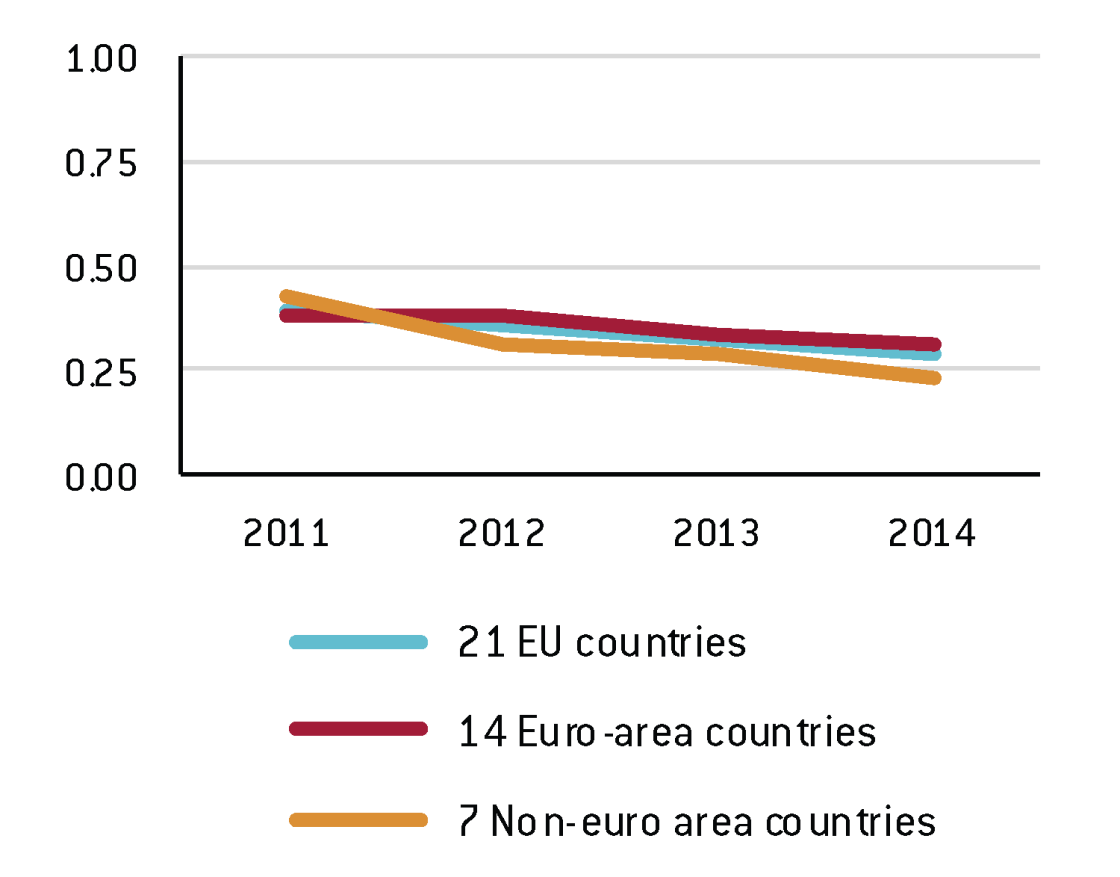
Source: Bruegel. Note: we gave a score of 1 to ‘full/substantial progress’, a score of 0.5 to ‘some progress’ and a score of zero to ‘no/limited progress’: our indicator is the ratio of the sum of the scores to the total number of recommendations. Progress assessments are based on European Parliament studies. We report an unweighted average of those 21 EU countries for which data is available for all years: Austria, Belgium, Bulgaria, Czech Republic, Denmark, Estonia, Finland, France, Germany, Hungary, Italy, Lithuania, Luxembourg, Malta, Netherlands, Poland, Slovakia, Slovenia, Spain, Sweden and the United Kingdom. The horizontal axis indicates the date of the European Semester recommendations.
2.2 The Stability and Growth Pact and Macroeconomic Imbalance Procedure implementation
We also check the implementation rates for the two main procedures included in the European Semester: the Stability and Growth Pact (SGP) and the Macroeconomic Imbalance Procedure (MIP), in comparison to recommendations that are not related to either of these procedures. Again, our indicators are based on the European Commission’s assessment.
Given that the SGP has strong legal enforcement tools, one would expect a high implementation rate for recommendations related to the SGP. There are some enforcement tools for the MIP under the Excessive Imbalance Procedure, but this procedure has not been so far activated for any country. The MIP has six phases ranging from ‘No imbalances’ to ‘Excessive imbalances, which require decisive policy action and the activation of the Excessive Imbalance Procedure’. Recommendations are more binding when the Excessive Imbalance Procedure is activated. Table 1 shows the 2015 status of the MIP.
Figure 2 shows that the implementation rate of recommendations related to the SGP tends to be higher than that for the MIP and other recommendations. The difference was particularly large for the 2013 recommendations, but narrowed by 2014. The average SGP implementation rate in 2012-14 was 44 percent, which is not particularly high and suggests that the European Semester is not particularly effective in enforcing the EU’s fiscal rules.
Figure 2: European Semester implementation rates according to the type of recommendations
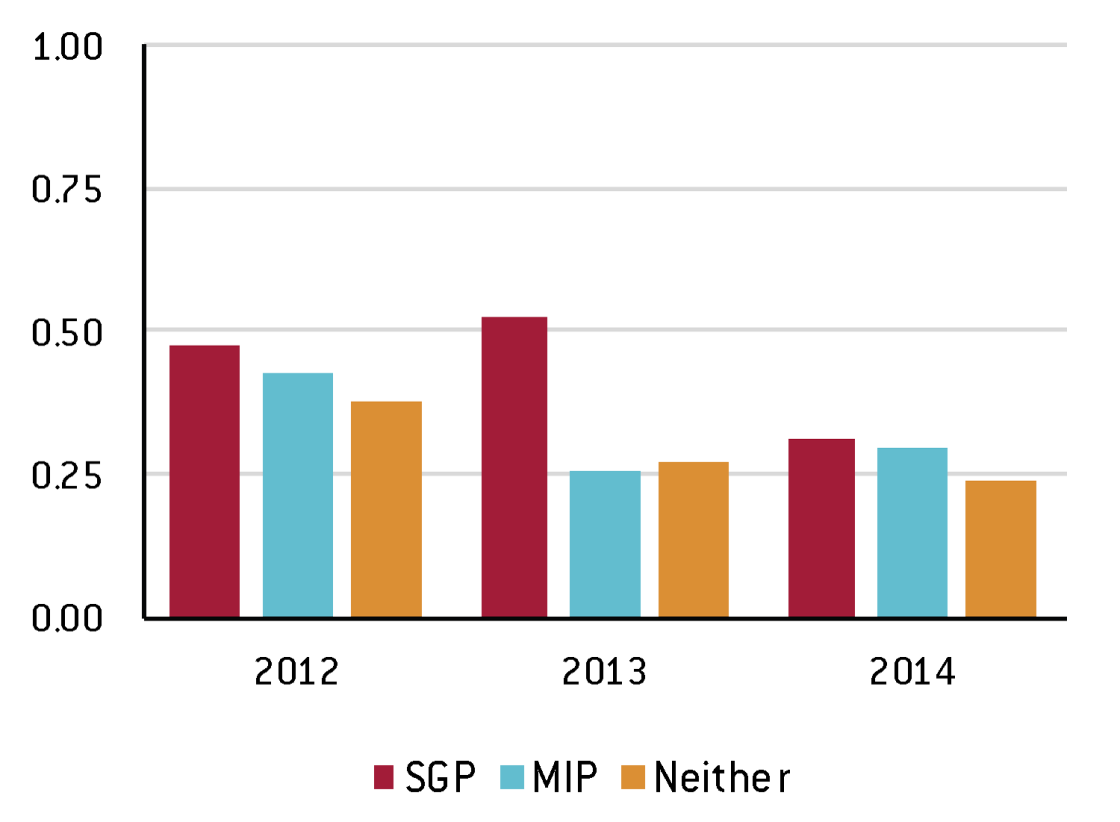
Source: Bruegel using European Commission and European Parliament data. Note: see the notes to Figure 1 for the method of calculating our index. Averages for the recommendations made for 21 countries are reported (programme countries and Croatia, which joined the EU in 2014, are not included). Some recommendations are related for both the SGP and MIP, which are taken into account for both procedures.
2.3 European Semester vs OECD recommendations
We would like to assess whether reform implementation has increased compared to the pre-crisis period (ie whether the European Semester had a positive impact on reform implementation), including reform implementation in countries under a financial assistance programme, which are not included in the regular European Semester recommendations and are also exempt from the obligation to submit medium-term budgetary plans or reform programmes. Therefore, we include in our analysis the implementation of the OECD’s Going for Growth recommendations, which are available for a longer time period for OECD member states, including countries which are under a financial assistance programme. The OECD recommendations are not part of any cross-country surveillance process and therefore there is no mechanism to coordinate these reforms across countries or to enforce them. The OECD calculates an indicator called ‘Overall reform responsiveness rates’, which is based on OECD staff assessment. This responsiveness indicator is calculated for two-year periods; for comparability, we also calculate our European Semester reform implementation index over the same periods.
Figure 3: Reform implementation: comparison of European Semester and OECD Going for Growth recommendations
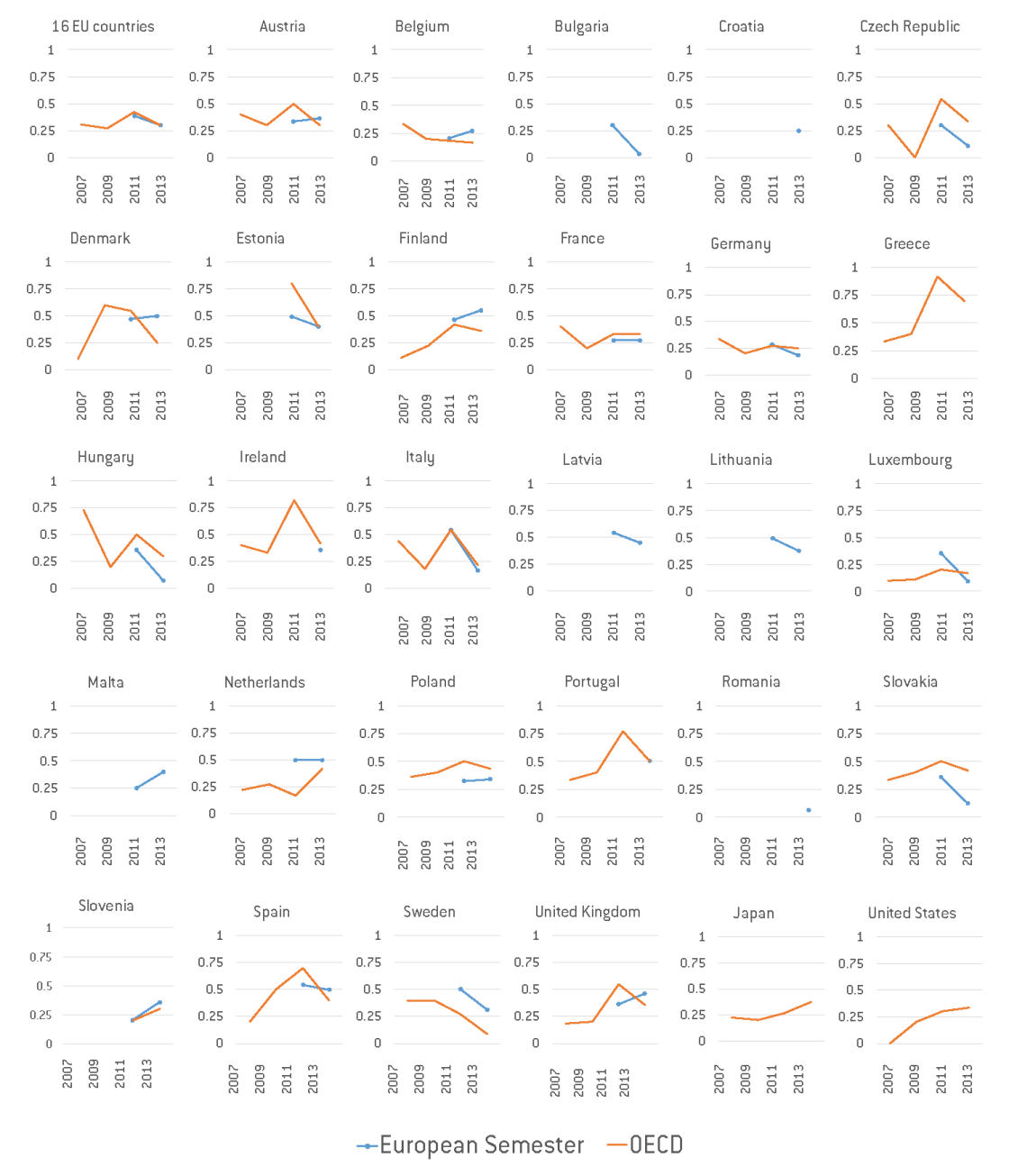
Source: Bruegel using European Commission, European Parliament and OECD data. See the notes in the PDF version of the publication.
The results are reported in Figure 3. The top-left panel (for 16 EU countries) shows a striking result: the two indicators are practically the same for those countries for which both European Semester and OECD recommendations were available in 2011-14. One reason for the similar values of the two indices is that there is some overlap between the European Semester and OECD recommendations (see Annex 1). However, the overlap is far from being perfect and therefore the similar implementation rates highlight the ineffectiveness of the European Semester: its implementation is not better than the OECD’s unilateral recommendations, despite the huge efforts by European institutions to coordinate economic policies within the European Semester. Moreover, the OECD’s reform responsiveness rate was practically the same in 2013-14 (30 percent) as in 2007-08 (31 percent), while it was somewhat higher in 2011-12 (42 percent). The somewhat higher rate in 2011-12 could be explained by increased efforts during the crisis, but from 2007-08 to 2013-14 there was no increase in reform implementation, notwithstanding the new European economic governance frameworks.
The other panels of Figure 3 show the two indicators (when available) for all EU countries except Cyprus, and for the United States and Japan4. The similarity we highlighted holds for almost every EU country.
Figure 3 highlights that the countries under a financial assistance programme or undergoing severe macroeconomic adjustments, implement the most. The highest reform responsiveness rate, 92 percent, was observed in Greece in 2011-12 according to the OECD. In the same period, the reform responsiveness rate was 82 percent for Ireland and 77 percent for Portugal. Estonia, a country undergoing severe macroeconomic adjustment, had a high score too (80 percent). Next in the ranking is Spain with a reform responsiveness rate of 70 percent. The only other occasion with a similarly high reform responsiveness rate was for Hungary in 2007-08 (73 percent), when Hungary had already started a major fiscal and macroeconomic adjustment process. In all of these countries, the reform responsiveness rate fell in the next time period (though it typically remained above the EU average), when either the financial assistance programme ended (Ireland and Portugal), or market pressure eased (Hungary and Spain), or when reform fatigue set in while continuing the financial assistance programme (Greece).
For those countries not under a financial assistance programme, or not undergoing severe macroeconomic adjustment, the reform implementation index remained very low, a result which also holds for the United States and Japan5. This suggests that implementation of reforms suggested by international organisations is generally low and that the European Semester was not able to improve this situation.
3. The 2015 euro-area recommendations
On 14 July 2015, the European Council adopted four recommendations for the euro area6:
- “Use peer pressure to promote structural reforms that facilitate the correction of large external and internal debts and support investment.” The specific elements mentioned are monitoring and assessing reforms by member states only in those countries that are under the MIP; regular thematic assessment of structural reforms; a coordination exercise to reduce the tax wedge on labour and to reform services markets.
- “Coordinate fiscal policies to ensure that the aggregate euro-area fiscal stance is in line with sustainability risks and cyclical conditions.” The specific elements emphasise the supremacy of Stability and Growth Pact rules; the need for thematic discussions on improvements in the quality and sustainability of public finances; and monitoring the functioning of national fiscal frameworks.
- Completing the EU’s financial unions: banking union (follow up to the ECB’s Comprehensive Assessment; implementation of the Bank Recovery and Resolution Directive; ratification of the Single Resolution Fund agreement) and capital markets union (“Promote measures to deepen market-based finance, to improve access to finance for SMEs and develop alternative sources of finance.”). Further reforms of national insolvency frameworks are also encouraged.
- “Take forward work on deepening Economic and Monetary Union…”, a recommendation that includes a reference to the Five Presidents’ Report.
Since our goal is to assess policy coordination under the European Semester, we take these recommendations as given and do not assess their desirability, though we note that in general, we agree with the aims of these headline recommendations. We highlight that in 2015, no recommendation has been made on the need for a symmetric adjustment within the euro area, even though such a recommendation was made in 2012, 2013 and 2014, and the preamble of the 2015 Council recommendation for the euro area also recognises that “External rebalancing is ongoing, but progress has been asymmetric and elevated current account surpluses in a few Member States persist”.
Our assessment of the four recommendations (and the lack of a recommendation for a more symmetric adjustment) takes three factors into account:
- First, we briefly comment on whether the specifics listed in the euro-area recommendations are sufficient to achieve the stated goals.
- Second, we assess the consistency between the euro-area recommendations and the CSRs, by focusing on the five largest euro-area countries.
- Third, we discuss the missing aspect of the symmetric adjustment in the euro area.
3.1 The specifics of the 2015 euro-area recommendations
The specific recommendations that underpin the first two euro-area recommendations are unlikely to be sufficient for achieving the stated goals. The third and fourth euro-area recommendations are more general and therefore such assessment cannot be made.
- As highlighted in the previous section, implementation of European Semester recommendations has been rather weak and even declining from 2011-14. While it is important to improve compliance, recommendation No. 1 made in 2015 does not seem to have had any power to improve compliance. Peer pressure did not work in the last four years and it is unclear why it would work better this year. Moreover, while “supporting investment” is included in the first sentence of this recommendation, no indication was given of how this goal should be achieved, beyond peer pressure.
- The reference to the aggregate fiscal stance is vague. We see two crucial problems: first, nothing is said about how the optimal fiscal stance should be determined, and second, no indication is provided on what “coordination” specifically means to achieve it. Certainly, improving the quality and sustainability of public finances and monitoring the functioning of national fiscal frameworks are important, but they are not directly linked to the aggregate fiscal stance of the euro area.
- The recommendation to complete Europe’s financial unions is welcome. We only highlight that this recommendation does not foresee new initiatives, but primarily aims for the ratification and implementation of previous agreements. Unfortunately, there is no reference to a common deposit insurance facility, which has become an intensively discussed topic7.
- Given that the Five Presidents’ Report was published shortly ahead of the July 2015 European Council meeting, a reference to this report was a must. We generally find the level of ambition of the Five Presidents’ Report weak, but a detailed assessment of that report is beyond the scope of this Policy Contribution.
3.2 Consistency of euro-area and country-specific recommendations
We classify the euro-area recommendations in four categories:
- Procedural recommendations, such as “use peer pressure” and “continue/hold thematic assessment of structural reforms/thematic discussions on improvements in the quality and sustainability of public finances”;
- Strategic thinking, such as “Take forward work on deepening Economic and Monetary Union”;
- Legal ratification and implementation of existing agreements, such as the completion of the ratification of the intergovernmental agreement on the Single Resolution Fund and the implementation of the Bank Recovery and Resolution Directive;
- Recommendations that aim to achieve certain tangible economic goals, such as
- “promote structural reforms that facilitate the correction of large internal and external debts”;
- “support investment”;
- “coordinate fiscal policies to ensure that the aggregate euro area fiscal stance is in line with sustainability risks and cyclical conditions”;
- “reducing the high tax wedge on labour”
- “reforming services markets”.
Euro-area recommendations belonging to the first two categories concern the Eurogroup and should not be repeated in country-specific recommendations. Recommendations on the implementation of existing laws should not be repeated in country-specific recommendations either, while ratification of agreements could be mentioned where it has not yet been done (category 3). Our focus therefore is on category 4 recommendations, which aim to achieve certain tangible economic goals. We assess whether they are sufficiently reflected in CSRs and whether the current institutional framework, along with the procedural recommendations in category 1, offers a good prospect for their implementation.
None of the category 4 recommendations include numerical targets, which complicates the assessment of their consistency with CSRs, while next year this feature will give the Commission much freedom to assess compliance with these recommendations. In our assessment we assume that the aim is to achieve ‘significant’ progress towards these economic goals and therefore we assess whether CSRs, if implemented, would be able to achieve ‘significant’ (as opposed to ‘marginal’) progress.
3.2.1 The aggregate fiscal stance
Over the past few years, the EU institutions have started paying more attention to the aggregate fiscal stance of the euro area. While the first 2011 European Semester did not include a recommendation on the aggregate fiscal stance, such a recommendation has been made in all subsequent rounds of the Semester (Table 2). The wording has been slightly different in different rounds, but the main message has been essentially the same as in 2015: “to coordinate fiscal policies to ensure that the aggregate fiscal stance is in line with sustainability risks and cyclical conditions”, which should be differentiated across countries and take into account the cyclical position and public debt sustainability of each country, while fiscal consolidation (where needed) should have a growth-friendly composition.
European Central Bank president Mario Draghi also emphasised the importance of the aggregate fiscal stance in his Jackson Hole speech in 2014 (Draghi, 2014): “it may be useful to have a discussion on the overall fiscal stance of the euro area. Unlike in other major advanced economies, our fiscal stance is not based on a single budget voted for by a single parliament, but on the aggregation of eighteen national budgets and the EU budget. Stronger coordination among the different national fiscal stances should in principle allow us to achieve a more growth-friendly overall fiscal stance for the euro area”.
However, notwithstanding the recognition by the Council, the European Commission and President Draghi of the importance of the aggregate fiscal stance, we find that the reference to the aggregate euro-area fiscal stance by the Council in euro-area and country-specific recommendations is little more than empty rhetoric. First, neither the Council, nor the Commission defines how the optimal fiscal stance should be determined. In addition, the Council does not even state what aggregate fiscal stance “is in line with sustainability risks and cyclical conditions”. While the Commission Staff Working Document on the euro area states that the current neutral aggregate fiscal stance is broadly appropriate and strikes a good balance between fiscal sustainability and cyclical conditions8, it is more a value judgement than the result of rigorous analysis, and the Council has not adopted this judgement.
Second, irrespective of the way the optimal fiscal stance is defined, the approach to achieving a desired aggregate fiscal stance is not top-down, whereby the optimal aggregate stance is taken as the starting point and national budgets are determined accordingly. Instead, the resulting aggregate stance is just the sum of national budgets and it is accidental if this sum is equal to what is considered optimal.
The preamble of the Council recommendation for the euro area highlights that “coordination of fiscal policies remains sub-optimal. A number of euro area Member States still need to continue with fiscal adjustment to bring down very high levels of debt. Other countries have more room for manoeuvre and could use it to encourage domestic demand, with a particular emphasis on investment; this would support domestic growth and the euro area as a whole”. It seems therefore that the conclusion about sub-optimal coordination was reached for two reasons: (1) countries with high debt might have not carried out sufficient fiscal consolidation to bring down public debt, and (2) countries with more fiscal space might have not seized the opportunity to encourage domestic demand, with an emphasis on investment. Despite this conclusion, the specific euro-area recommendation on the aggregate fiscal stance did not consider aspect (2) by referring to the use of available fiscal space, and similar recommendations were not reflected in the CSRs of those countries that have “more room for manoeuvre”.
In particular, for Germany, the European Commission recommendation of 13 May 2015 included a slight attempt at fostering a reduction of the fiscal surplus9:
“Further increase public investment in infrastructure, education and research, including by using the available fiscal space.”
However, the recommendations approved by the Council no longer included the reference to the use of available fiscal space:
“Further increase public investment in infrastructure, education and research.”
Certainly, it is the legitimate right of the Council to decide on a tighter fiscal stance than what is proposed by the Commission, similar to the right of a government to adopt a tighter fiscal policy than what is suggested by its fiscal council. But the removal of the reference to the use of the available fiscal space underlines that even though the Council acknowledged that one of the two aspects of sub-optimal fiscal policy coordination is that countries with fiscal space do not encourage domestic demand, no attempt is needed to remedy this problem10 .
Furthermore, we highlight that while the conclusion about the desirability of the aggregate neutral fiscal stance is included only in the Commission Staff Working Document, but not in the Council recommendations, the CSRs for the five largest euro-area countries are not consistent with this aggregate view. For France and Spain the fiscal consolidation recommendation is in-line with the on-going Excessive Deficit Procedure, while for Italy it is in line with the preventive arm of the SGP. Therefore, to achieve a neutral aggregate fiscal stance, fiscal consolidation in three of the five largest euro-area countries (France, Italy and Spain) should have been compensated for by fiscal expansion in other large countries, but this was not recommended to Germany or the Netherlands11.
3.2.2 Support investment
There is a lot of emphasis in various Commission reports on the importance of increasing investment. The Commission Staff Working Document on the euro area (which does not necessarily reflect the view of the College of Commissioners) presented a simulation result demonstrating the importance of public investment12. The importance of investment is also highlighted in the preamble of the Council recommendations (“a wide investment gap has opened”) and is reflected by its inclusion in two of the Council’s four euro-area recommendations. Yet we conclude that this euro-area goal is not well reflected in CSRs.
For France, the fifth CSR includes a reference to investment: “To promote investment, take action to reduce the taxes on production and the corporate income statutory rate, while broadening the tax base on consumption.”
For Germany, the first recommendation is: “Further increase public investment in infrastructure, education and research. To foster private investment, take measures to improve the efficiency of the tax system, in particular by reviewing the local trade tax and corporate taxation and by modernising the tax administration. Use the ongoing review to improve the design of fiscal relations between the federation, Länder and municipalities, particularly with a view to ensuring adequate public investment at all levels of government.”
For the Netherlands, the first recommendation is: “Shift public expenditure towards supporting investment in R&D and work on framework conditions for improving private R&D expenditure in order to counter the declining trend in public R&D expenditure and increase the potential for economic growth.”
For Italy and Spain, investment is not even mentioned in their CSRs.
We conclude that these CSRs are insufficient to foster a reasonable increase in public and private investment.
Public investment: As we noted above, the Commission’s proposal to use “the available fiscal space” was deleted by the Council from the German recommendation on public investment. This implies that a public investment stimulus should not be expected, only a change in the composition of public expenditures in favour of investment, similarly to the Netherlands. In our view, one should not expect much from changing the composition of public spending, certainly not the 1 percent of GDP extra investment stimulus, the effects of which were simulated in the Commission Staff Working Document on the euro area, as we noted above. France, Italy and Spain did not receive recommendations to increase public investment.
Private investment: France and Germany are recommended to make their tax systems more efficient, which is certainly welcome, but we do not expect a major private investment boom as a result. Italy, the Netherlands and Spain were not recommended to boost private investment.
Therefore, we conclude that while fostering investment is a top priority at the euro-area level, this recommendation is not well reflected in the CSRs of the five largest euro-area countries.
3.2.3 Facilitate the correction of large internal and external debts
The first euro-area recommendation invites euro-area countries to use peer pressure to promote structural reforms that facilitate the correction of large internal and external debts.
The Commission itself, in the 2015 Alert Mechanism Report13, identifies excessive imbalances concerning private debt (in the Netherlands and Spain) and public debt (in Italy and Spain). However there are almost no recommendations to address large private debt overhangs; only Italy is recommended to “take measures to accelerate the broad-based reduction of non-performing loans”.
Regarding public debt, if we accept the premise that cutting deficits during a recession will successfully reduce public debt, then the euro-area recommendation to correct large public debts is reflected in the cases of France and Spain, which are invited to correct their excessive deficits, and Italy, which is recommended to comply with the rules of the preventive arm of the SGP. Germany and the Netherlands do not have large public debts and therefore lack of such a reference is to be expected.
3.2.4 Reduce the high tax wedge on labour
The first euro-area recommendation includes a sub-recommendation on reducing high tax wedges on labour. The importance of this issue is also mentioned in the preamble to the Council recommendations. Box 2 of the European Commission Staff Working Document accompanying the euro-area recommendations presents numbers on the tax wedge and identifies very high tax burdens on labour in Germany, France, Spain and Italy. However, only Germany received a recommendation to “take measures to reduce high labour taxes”.
Moreover, the same Staff Working Document admits that “shifts away from labour taxes to more growth-friendly taxes such as consumption, recurrent property and environmental have been taking place but these reforms remain relatively modest compared to the challenge”. If reforms were modest, it is surprising that this issue, which the Council agrees is important, has not appeared in the CSRs to the four other countries.
We conclude that the recommendation to reduce the high tax wedges on labour is not well reflected in the CSRs to the five largest euro-area countries, despite the apparent consensus about the importance of the issue.
3.2.5 Reform services markets
This recommendation is well reflected in the CSRs. France, for example, is recommended to “Remove the restrictions on access to and the exercise of regulated professions, beyond the legal professions, in particular as regards the health professions as from 2015.” Germany is recommended to ”take more ambitious measures to stimulate competition in the services sector”. In its sixth recommendation to Italy, the Council invites it to “adopt competition-enhancing measures in all sectors covered by the competition law, and take decisive action to remove remaining barriers”. Finally, Spain is recommended to “adopt the planned reform on professional services”. There is no related recommendation for the Netherlands.
We conclude that this euro-area recommendation is indeed well reflected in the CSRs of the five largest euro-area countries. Each country, except the Netherlands, received a recommendation to reform its services sector in some way.
3.3 Lack of symmetric adjustment within the euro area
In 2012, 2013 and 2014, the Council made recommendations for more symmetric adjustment within the euro area, but the recommendation has disappeared by 2015 (Table 3).
In 2012, the recommendation called for “an orderly unwinding of intra-euro area macroeconomic imbalances”: by definition, intra-euro imbalances include both deficits and surpluses. In 2013, the recommendation was even clearer by explicitly mentioning current account surpluses: “correction of external and internal imbalances” was recommended, with a particular emphasis on addressing “distortions to saving and investment behaviour in Member States with both current account deficits and surpluses”. In 2014 a similarly clear and strong recommendation was made: “Foster appropriate policies in countries with large current account surpluses to contribute to positive spillovers.” It is very surprising that despite the importance of symmetric intra-euro adjustment, which was also recognised by the 2015 Commission Staff Working Document on the euro area, this recommendation has disappeared from the 2015 recommendations for the euro area. Relevant recommendations are not included in CSRs either.
Indeed, the adjustments of current account balances were asymmetric: deficit countries adjusted, but surpluses continued growing (Figure 4).
Figure 4: Current account balance of the euro area (€ billions), 1999-2015
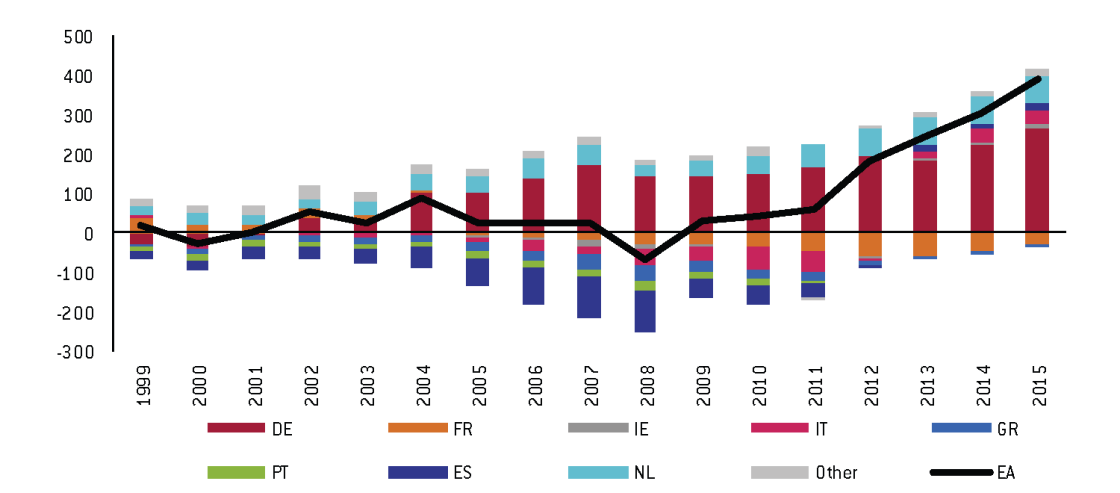
Source: AMECO database November 2015.
The disappearance of the call for symmetric adjustment from the euro-area recommendations is in contrast to the main conclusions included in the Commission Staff Working Documents (which, as we have already highlighted, might not necessarily reflect the views of the College of Commissioners). The preamble of the 2015 Council recommendation agrees that "external rebalancing is ongoing, but progress has been asymmetric and elevated current account surpluses in a few Member States persist"14.
As the Commission argues in its Staff Working Document accompanying its 2015 CSRs to Germany, Germany’s close links to the rest of the euro area, especially through trade and financial markets, mean that economic spillovers can be potentially large. Therefore both Germany and the rest of the euro area would benefit from higher levels of investment in Germany and a reduction in its current account surplus: the resulting higher domestic demand in surplus countries “is the only other way of closing the output gap of the euro area as a whole”15, given the constraints on monetary and fiscal policy. The IMF (2015a, 2015c) drew the same conclusion. By estimating panel-econometric models for the medium-term determinants of current account balances, Darvas (2015) concluded that European current account surpluses became excessive during the past twelve years, while they were in line with model predictions in the preceding three decades.
Consequently, the disappearance of the call for symmetric adjustment from the euro-area recommendations suggests that the Council disagrees with the findings of Commission staff, IMF reports and some academic research.
We have to conclude that there has been no improvement since 2013, when Darvas and Vihriälä (2013) concluded that “A major drawback is that the Council recommendations do not give sufficient importance to symmetric intra-euro area adjustments. Reference to the euro area’s ‘aggregate fiscal stance’ is empty rhetoric. Insufficient attention is paid to demand management. The most comprehensive recommendations are made on structural reforms.”
4. Proposals for an improved European Semester
Our key conclusions showing that implementation of 2011-14 CSRs has been weak and has even declined, and that there are major consistency problems between the 2015 euro-area recommendations and CSRs, are in sharp contrast to the self-congratulation included in the Commission Staff Working Document on the euro area16. Efforts to improve the European Semester are badly needed.
4.1 On-going reforms
The European Commission has already “streamlined” the 2015 European Semester by further prioritising and shortening the recommendations, by publishing CSRs and euro-area recommendations three months earlier than in previous years to enable more discussion with various stakeholders, and by aiming more intensive outreach. Thus some of the proposals of Hallerberg, Marzinotto and Wolff (2012a, 2012b) have been adopted. The length of recommendations generally increased between 2011-14, while there was a major cut-back in 2015.
Recent proposals to revamp the European Semester go in the right direction. According to the Five Presidents’ Report, and a European Commission communication on 21 October 2015 (European Commission, 2015b), the European Semester is to be split into two stages: first there will be discussions and recommendations about the euro area, and only then will CSRs be discussed and decided on, which should reflect the common challenges identified in the first stage. In our view, this is a welcome reform of the European Semester.
On 21 October 2015, the Commission also issued its decision on the establishment of an independent advisory European Fiscal Board (European Commission, 2015c). This board will provide to the Commission an evaluation of the implementation of the fiscal framework, but it will also “advise the Commission on the prospective fiscal stance appropriate for the euro area as a whole”, and “may advise the Commission on the appropriate national fiscal stances that are consistent with its advice on the aggregate fiscal stance of the euro area within the rules of the Stability and Growth Pact”. This is a very welcome development in our view and at least partly in line with the proposal of Darvas and Vihriälä (2013), who suggested the establishment of an independent fiscal authority responsible for the definition and management of the euro area’s aggregate fiscal stance. The Fiscal Board should promote a much-needed discussion of the aggregate fiscal stance in the first stage. It could also improve coordination by pointing out which countries have fiscal space, and should implement more expansionary fiscal policy in order to bring the aggregate fiscal stance to desired levels: this was an element that was clearly missing in the CSRs, as we have pointed out.
However, according to the Commission’s 21 October 2015 proposal, the Fiscal Board can give advice only within the SGP rules, so it will not be free to define the optimality of the aggregate fiscal stance. It will not have the power to manage the fiscal stance and the European Commission will not be obliged to incorporate the suggestions of the Fiscal Board when deciding about euro-area recommendations and CSRs. But even if the Fiscal Board one day concludes that some countries should have more expansionary fiscal policies, and both the Commission and the Council endorse that conclusion, there will not be many instruments to enforce it. While countries can be required to reduce their debts and deficits according to the regulations of the Stability and Growth Pact, there exists no mechanism by which countries can be required to enact fiscal expansion. This process could be supported by the use of the Excessive Imbalance Procedure for countries with too-large current account surpluses, for example by requiring an increase in public investment. While non-compliance with such a recommendation could in principle lead to sanctions under the current rules, even in the best case, influencing countries via the MIP to increase their public investment would take several years, while the optimal fiscal stance should be achieved promptly. Moreover, not all countries with fiscal space have excessive current account surpluses.
In terms of the implementation of structural reforms, the most promising proposal in our view is the establishment of a euro-area system of competitiveness authorities, composed of independent national councils, a proposal made by Sapir and Wolff (2015) and endorsed by the Five Presidents’ Report. On 21 October 2015 the European Commission proposed a Council Recommendation on the establishment of National Competitiveness Boards within the euro area (European Commission, 2015e). The national councils would assess wage and productivity developments and economic reforms to foster competitiveness, while their European network should help to exploit their synergies.
We see the establishment of national competitiveness councils as a kind of decentralisation, through which reform priorities would be defined nationally. It will likely increase the ownership of the reform process because a conclusion by such a national council could be seen by the national parliament and the government as a recommendation coming from inside the country, but not as an intrusion from Brussels. In our view, this is a very welcome proposal. However, it needs to be seen to what extent national councils would be able to internalise the cross-border implications of the reform process, and we are sceptical about this. The proposed recommendation includes a reference to euro-area considerations: “The Commission should facilitate coordination between national competitiveness boards and exchange views with them, in particular to ensure the consideration of euro-area and EU objectives in the work of the boards.” While discussions and information exchanges can foster mutual understanding of the cross-country spillover effects of domestic policies, ultimate decisions remain national. So far the MIP has been ineffective in internalising cross-country spillover effects, partly because of major disagreements about the significance of such affects, and therefore it remains to be seen if the coordination of national competitiveness boards would be able to achieve common understanding leading to policy actions.
Nevertheless, the establishment of such competitiveness boards would be a major improvement compared to the current governance framework in our view, even if the national boards primarily focus on the domestic consequences of the reform process.
4.2 Further possible reforms
4.2.1 The aggregate fiscal stance
Political federations have central and sub-central budgets. In a federation, fiscal stabilisation (which has implications for the aggregate fiscal stance of the federation) is mostly the job of the federal government through automatic stabilisers and discretionary fiscal decisions. The euro area is not a political federation and does not have a central budget. The EU has a budget, but its aim is not fiscal stabilisation. We believe that a euro-area fiscal stabilisation instrument would be more helpful for aligning the aggregate fiscal stance with the aggregate economic situation of the euro-area (see, for example, Darvas, 2012; Wolff, 2012; Pisani-Ferry, Vihriälä and Wolff, 2013) than coordination of fiscal policies of member states. A federal stabilisation instrument could also let national fiscal policies to follow national preferences when fiscal rules are not binding. However, there are also opposing views about the desirability of a (small) euro-area budget or any other centralised fiscal stabilisation instrument. Opponents argue that if European fiscal rules are met, member states will have sufficient room for manoeuvre for stabilising their own economic cycles using their own fiscal policies. In any case, the Five Presidents’ Report incorporated a related proposal only for the long term, so we do not expect a euro-area fiscal instrument in the foreseeable future.
Similarly, the prospect of a euro-area mechanism that would force countries to have higher budget deficits, as suggested by, for example, Sapir and Wolff (2015), is extremely unlikely. As we highlighted earlier, even the modest attempt of the European Commission to include in Germany’s 2015 CSR a clause to encourage the government to use its fiscal space was deleted by the Council. While parliaments and governments can change, we see no political possibility of countries agreeing to a binding process that might force them to have deficits that are larger than their domestic preferences would deem appropriate.
In the absence of a euro-area fiscal stabilisation instrument or a mechanism to force counties to have larger budget deficits, the remaining options to influence the aggregate fiscal stance are rather limited. In any case, the European Fiscal Board should be entrusted with the definition of an unconstrained optimal aggregate fiscal stance (ie the fiscal stance disregarding SGP rules) and its constrained version which considers the SGP rules. This exercise should be done for the euro area as a whole and for each euro-area member state. Such an exercise would help foster discussions, but the problem will remain that there will be no enforcement mechanism to require expansionary fiscal policy.
To sum up, we see it as extremely unlikely that any coordination mechanisms or the use of the MIP would enable countries to be forced to have larger deficits than their national preferences would suggest. We are sceptical about whether the optimal aggregate fiscal stance could be achieved by anything other than pure chance. We expect that vague statements will continue to be made in the future about the aggregate fiscal stance and the benefits of coordination.
4.2.2 The implementation of structural reforms
A number of proposals have been made on the implementation of structural reforms. The IMF (2015b) and Banerji et al (2015) suggested some ways to enhance the implementation of structural reforms. These include the definition of “outcome-based” benchmarks, which are sufficiently concrete, measurable and directly under the control of policymakers, and the use of EU legislation where possible instead of coordination. Such proposals were included in the Five Presidents’ Report for the medium term (“Stage 2”, which should be completed by 2025). The proposal aims to formalise and make more binding the convergence process by “agreeing on a set of common high-level standards that would be defined in EU legislation, as sovereignty over policies of common concern would be shared and strong decision-making at euro area level would be established”. While setting benchmarks may be useful, Terzi (2015b) highlights that structural reforms cannot be objectively measured. He demonstrates that some of the indicators proposed by Banerji et al (2015) show very significant variations between the countries that are at the top of the World Economic Forum World Competitiveness Report rankings. We also see difficulties in enforcement and making the system binding if a country does not meet the standards by the agreed time.
Some further proposals were also made by IMF (2015b) and Banerji et al (2015) to strengthen incentives, such as direct financial transfers from the EU to cover reform costs and support implementation, a proposal that echoes the 2013-14 discussion on “contracts for competitiveness and growth”. One key problem with such a contract, as emphasised by Pisani-Ferry (2013), is that such a grant in exchange for a particular reform would be seen by domestic stakeholders as a bribe by which European partners want to enforce a reform on the country. The popularity of the government entering into such a contract might fall quickly. Even if the reform proposal originally comes from the country in question, domestic stakeholders might perceive it as coming from European partners.
There are other problems too. Such contracts or any other financial incentives, such as a reallocation of EU-sponsored investments to countries that implement European Semester reform suggestions, would reward countries that are slow to implement reforms. Those countries that followed the European Semester advice earlier would not benefit from such a contract, while providing retroactive contracts to reward those countries that have already implemented reforms would lead to a very messy system. Moreover, financial incentives would not really matter for larger countries with sound fiscal positions. For example, we see it as inconceivable that Germany would speed up services market reforms on the basis that it would receive a few billion euros from other euro-area countries.
Banerji et al (2015) also suggest ex-post monitoring of reform implementation by an independent EU-level “structural council”. We find this proposal worth consideration, not least because independent evaluation could improve transparency and could highlight the steps the European Commission could take to improve the cross-country consistency of CSRs.
In terms of increasing the domestic ownership of the reform process, some proposals in the Five Presidents’ Report and the 21 October 2015 Commission Communication on steps towards completing economic and monetary union point in the right direction. For example, Hallerberg, Marzinotto and Wolff (2012a, 2012b) suggested enhancing the role of national parliaments at the EU level, enhancing the role of European institutions at member-state level and increasing the role of the European Parliament in the European Semester. These suggestions are endorsed by the Five Presidents’ Report. Similarly to the establishment of national competitiveness councils, we see the greater involvement of national parliaments, governments and social partners in the discussion of the reform process as a means of decentralisation, which can improve ownership of the process.
Concluding remarks
The European Semester was enacted in 2011 with the consent of the Council and the European Parliament to foster economic policy coordination, to enforce the overhauled Stability and Growth Pact and the new macroeconomic imbalance rules, and to achieve Europe 2020 targets. Despite the collective decision to create this new system of policy coordination, our findings show that the European Semester has been rather ineffective. This failure highlights the fundamental problem of policy coordination in the EU: national policymakers are accountable to their national parliaments and focus on national interests, which in many cases differ widely in different member states. Unless many member states face a common threat, such as the existential threat to the euro in 2011-12, coordination between national policymakers will always have limitations.
The question that naturally arises is if the European Semester is worth the effort, another policy coordination system should be designed, or even policy coordination should be scrapped. In our view, given the cross-country implications of various national policies and the specific set-up of the euro area, with centralised monetary policy and banking oversight while most fiscal and economic policies are decentralised, some form of dialogue between member states is needed. The European Semester has a legal basis and we do not believe that any other method of policy coordination is likely to work much better, because of the fundamental problem we have highlighted above. Therefore, efforts to revamp the European Semester are welcome, but expectations about possible achievements should be realistic.



